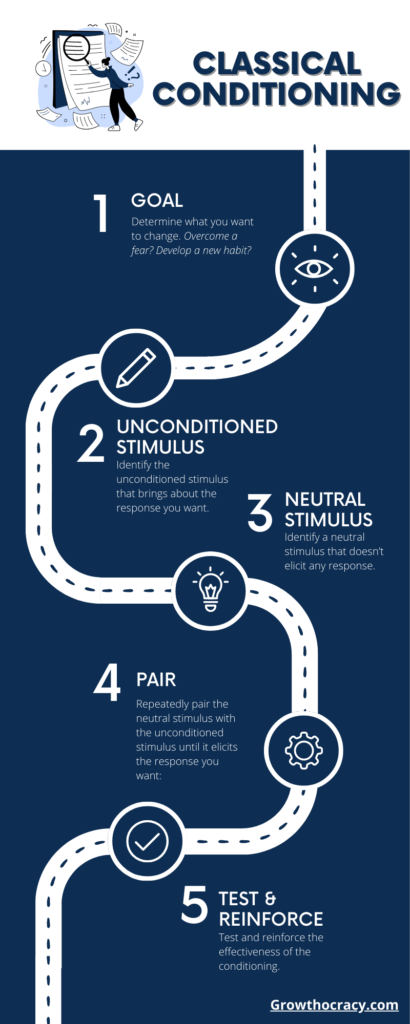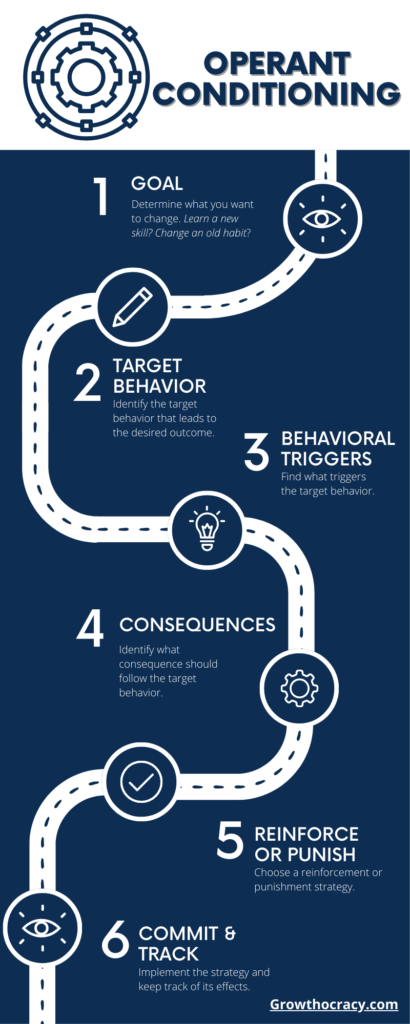Personal growth boils down to one simple yet powerful truth: you have the power to change your thoughts, feelings, and behaviors.
How?
Conditioning techniques.
More specifically, classical conditioning and operant conditioning. Both techniques create associations between stimuli to promote learning. By tweaking those associations, you can swap out negative patterns that hold you back and replace them with positive ones that push you forward.
Let’s take a look at the main types of conditioning in psychology and how you can apply them to your own personal growth goals.
Classical conditioning
What is classical conditioning?
This conditioning technique pairs two stimuli together to elicit a desired response. Remember Pavlov’s dogs? Pavlov trained dogs to salivate—a fancy way to say “drool”—from the sound of a bell. It went like this:
-
- Unconditioned stimulus (UCS) leads to an unconditioned response (UCR): Pavlov brought food (UCS) to the dogs and they salivated (UCR).
-
- Neutral stimulus (NS) leads to nothing: Pavlov rang a bell (NS) and the dogs did nothing.
-
- Neutral stimulus (NS) plus unconditioned stimulus (UCS) leads to an unconditioned response (UCR): Pavlov rang a bell (NS), showed some food (UCS), and then the dogs salivated (UCR).
-
- Conditioned stimulus (CS) leads to conditioned response (CR): Pavlov rang the bell (CS) without showing food and the dogs still salivated (CR).
Initially, the bell was meaningless and the dogs gave no response (beyond mild confusion). However, after ringing the bell and bringing the food repeatedly, the dogs associated the bell with food. In the end, the sound of the bell was enough for the dogs to salivate.
Although pairing sounds with salivation is interesting, it’s not particularly useful for personal growth. Luckily, the same basic technique can be used to overcome phobias, develop healthy habits, change negative attitudes, enhance self-esteem, or cultivate positive emotions.
Personal growth through classical conditioning
-
- Phobias: In theory, you can overcome the fear of snakes or spiders by pairing the sight of one with a pleasant stimulus, such as your favorite song or a calming image. After repeated pairings, you’ll associate the creature with positive feelings or calm imagery, thus reducing your fear.
-
- Habits: Train yourself to exercise more by pairing it with a rewarding stimulus, such as a tasty snack or a compliment. After repeated pairings, your brain will associate exercise with pleasure and your motivation will increase.
-
- Attitudes: You can change a negative attitude, such as prejudice or bias, by pairing the target group with a favorable stimulus, such as a role model or a positive message. After repeated pairings, you’ll associate that group with respect and reduce negative stereotypes.
-
- Self-esteem: Enhance your self-esteem by pairing the sight of yourself in a mirror with a supportive stimulus, such as a mantra or affirmation. After repeated pairings, you’ll associate yourself with confidence and improve your self-image.
-
- Emotions: Cultivate positive emotion, such as gratitude or joy, by pairing the occurrence of a daily event with a grateful or joyful stimulus, such as a thank-you note or a smile. After repeated pairings, you’ll associate the event with happiness and increase your well-being.
How do you practice classical conditioning?
To use classical conditioning techniques to promote your own personal growth goals, follow these 5 steps:
-
- Determine what you want: is it to overcome a fear, develop a habit, change an attitude, enhance self-esteem, cultivate positive emotions, or something else?
-
- Find the unconditioned stimulus that brings about the response you want: if you want to overcome a fear, that stimulus could be a soothing melody that elicits a sense of calm.
-
- Identify a neutral stimulus that doesn’t elicit any response: to overcome a fear of spiders, that neutral stimulus may be a picture of a spider that doesn’t scare you.
-
- Repeatedly pair the neutral stimulus with the unconditioned stimulus until it elicits the response you want: pair the neutral picture of the spider with the soothing melody until it brings calm.
-
- Test and reinforce the effectiveness of the conditioning: look at the picture of the spider itself without the soothing melody to see if it brings calm. Every so often, repeat the pairing of the spider picture with the soothing melody to elicit calm.

Operant conditioning
What is operant conditioning?
This type of psychological conditioning reinforces or punishes a behavior based on its consequences, encouraging you to increase or decrease how often you do it. Reinforcement increases a behavior’s likelihood, while punishment decreases it. There are two types for each:
-
- Positive reinforcement: receiving something desirable increases the likelihood of a behavior (e.g. earning badges on a language app after completing a certain level).
-
- Negative reinforcement: the ability to remove something undesirable increases the likelihood of a behavior (e.g. the annoying beeping sound that gets you to put your seatbelt on).
-
- Positive punishment: adding an undesirable consequence decreases the likelihood of a behavior (e.g. having to pay a fine after breaking a rule).
-
- Negative punishment: removing something desirable decreases the likelihood of a behavior (e.g. blocking your favorite apps when you procrastinate too much).
Although most psychologists prefer reinforcement over punishment, both are useful. Operant conditioning can help you overcome bad habits, reach goals, improve your health, learn a new skill, and boost creativity.
Personal growth through operant conditioning
-
- Habits: quit procrastinating by giving yourself an unpleasant sensation when you do. Wear a rubber band around your wrist, snap it every time you find yourself on YouTube for too long, and your procrastination will decrease.
-
- Goals: improve your ability to learn new skills by giving yourself a pleasant treat when you do. Reward yourself with a movie or favored dish after studying for a certain amount of time, and your motivation to study will increase.
-
- Improve health: if you have a goal of cutting some excess weight, try removing something pleasant whenever you overeat or skip an exercise. Take away a favorite food item from your fridge to boost your likelihood of eating moderately and exercising more.
-
- Skills: learn a new skill by losing something valuable if you don’t. For example, donating to a cause you dislike every time you fail to practice will increase your likelihood of practicing.
-
- Boost creativity: boost your creativity by setting up a random reward system. Surprise yourself with a reward, and the excitement and unexpectedness will increase your persistence and creative output.
How do you practice operant conditioning?
To use operant conditioning techniques to promote your own personal growth goals, follow these 6 steps:
-
- Define your desired outcome: do you want to quit procrastinating, improve your concentration, exercise more, learn to play guitar, or achieve something else?
-
- Identify the target behavior that leads to the desired outcome: if you want to stop procrastinating, your target behavior could be resisting the urge to aimlessly scroll.
-
- Find what triggers the target behavior: if you want to stop procrastinating, your triggers might include feeling stressed, bored, or tired.
-
- Identify what consequence should follow the target behavior: if you want to stop procrastinating, your target behavior might be feeling productive and focused.
-
- Choose a reinforcement or punishment strategy: if you want to feel productive and focused, you can deploy positive reinforcement by giving yourself a reward every time (or every few times) you resist the urge to scroll.
- Implement the strategy and keep track of its effects: if you decide to reward yourself with a compliment every time you resist the urge to scroll, keep track of how much more productive you become.

Limits and proper use of techniques
Both classical and operant conditioning can promote personal growth, but they aren’t perfect.
Classical conditioning may result in unwanted associations that are difficult to undo. It can also be used manipulatively, eating away at your sense of autonomy. Operant conditioning may result in dependency. For example, you may become so focused on external rewards that you weaken your sense of intrinsic motivation or lose interest in certain activities.
That being said, you can certainly use both techniques in an ethical and effective way. Here are some general guidelines:
-
- Only using psychological conditioning for positive and constructive purposes.
-
- Pay attention to feedback from yourself and others.
-
- Use safe and suitable stimuli and responses.
-
- Consider your own personality, needs, and challenges to adapt the conditioning techniques to your unique situation.
-
- Monitor and evaluate the results and consequences of conditioning, particularly any side effects.
-
- Compare your results with what you were hoping to achieve, and address any issues.
Time to grow
Whether you’re trying to exercise more, build self-esteem, learn a new skill, or boost your creativity, classical and operant conditioning can be powerful tools. Although they differ a little, both help you put into action the fundamental insight that drives personal growth: you have the power to change your thoughts, feelings, and behaviors.